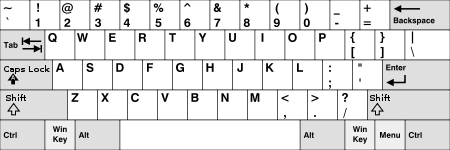- Delete key
-
The delete key (Delete or Del), known less ambiguously as forward delete, performs a function when struck on a computer keyboard during text or command editing, which is to discard the character ahead of the cursor's position, moving all following characters one position "back" towards the freed letterspace. The key appears on IBM-compatible PC keyboards labeled as Delete, or Del. On Mac keyboards, the key which performs the forward delete function is labeled del,[1] or with a special right arrow glyph enclosing an "x" with the word del or delete above or to the left of it,[2] as the full word delete by itself is reserved for labelling the key otherwise known as Backspace.
On Unix-like systems, the delete key is usually mapped to ESC [3 ~ which is the VT220 escape code for the "delete character" key[clarification needed].[3]
On many notebook computer keyboards the key labeled Delete (sometimes Delete and Backspace are printed on the same key) serves the same purpose as a Backspace key. Othertimes, the Delete Key is in its original IBM notebook position of above and to the right of the Backspace key. Many laptops add rows of smaller keys above the Function Key line to add keys on a non-standard size keyboard. On this row of smaller keys the Delete Key is often the third key in from the right. On Apple Inc.'s line of laptops (e.g. the MacBook and MacBook Pro), the forward delete function can be achieved using the Fn+delete (backspace) key combination.
Sometimes this desired effect is replaced by inserting Control-H (or, less frequently, Control-?) instead. This is related to ASCII control characters for BS and DEL.
Also, the delete key often works as a generic command to remove a selected object, such as an image embedded in a document (on Macs both the forward delete key and the delete (backspace) key have the same effect when pressed while an object is selected[1]).
The delete key, on many modern motherboards, also functions to open the BIOS setup screen when pressed after starting the computer.
References
- ^ a b "Forward Delete (Fwd Del)". Apple Human Interface Guidelines. http://developer.apple.com/library/mac/#documentation/UserExperience/Conceptual/AppleHIGuidelines/XHIGUserInput/XHIGUserInput.html#//apple_ref/doc/uid/TP30000361-CECIEFIA.
- ^ Image of the keyboard layout of a full-sized aluminum Apple keyboard
- ^ "9.8 Keyboard configuration". Debian Policy Manual. http://www.debian.org/doc/debian-policy/ch-opersys.html#s9.8.
See also
Esc F1 F2 F3 F4 F5 F6 F7 F8 F9 F10 F11 F12 PrtScn/
SysRqScrLk Pause/
BreakIns Home PgUp Num Lock / * - Del End PgDn 7 8 9 + 4 5 6 ↑ 1 2 3 Ent ← ↓ → 0 . Keyboard keys Dead keys Modifier keys Lock keys Navigation Editing Misc. System request/Print screen · Break/Pause · Escape · Menu · Numeric keypad · Function · Power management (Power, Sleep, Wake) · Language input · any key · Macro key ·Categories:- Computer keys
Wikimedia Foundation. 2010.


